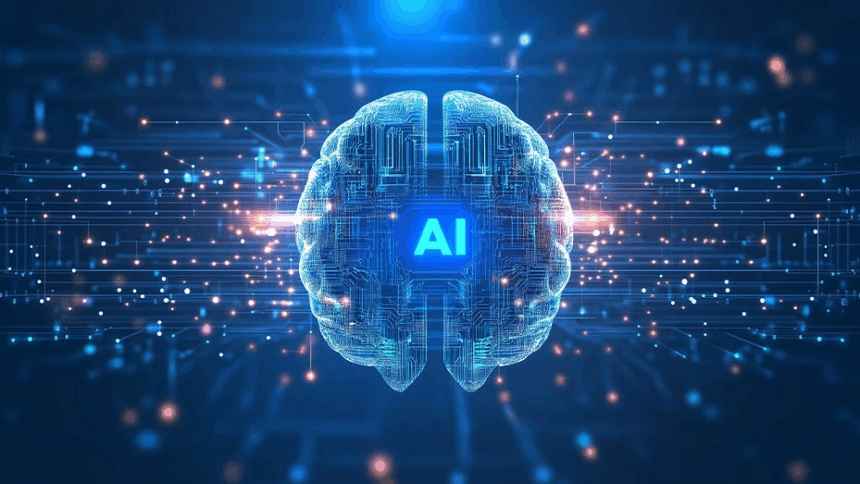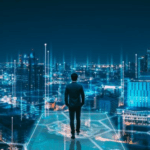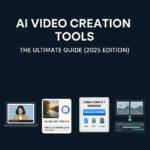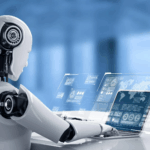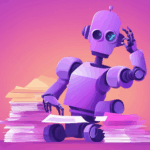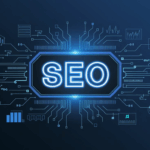Artificial intelligence (AI) has moved from being a futuristic concept to the defining technology of the 21st century. Over the past decade (2015–2025), we’ve seen AI evolve from powering recommendation engines and chatbots to creating art, music, video, code, and even entire business strategies. Tools like ChatGPT, MidJourney, and Gemini have become household names, showing just how far AI has progressed.
But what lies ahead? As we step into 2025, the next ten years promise even more transformative AI innovations — not just in how we work, but in how we live, learn, heal, and connect. From breakthroughs in healthcare and education to advancements in robotics, finance, and sustainability, AI will be the engine behind global change.
This article dives deep into AI predictions 2025–2035, analysing upcoming trends, innovations, and the future impact of artificial intelligence across industries and society. Whether you’re a business leader, student, or curious reader, this guide will give you a clear picture of where AI is heading in the next decade.
Why AI Predictions Matter for 2025–2035
The Pace of AI Development
Technology is evolving faster than ever. Just in the last few years, large language models (LLMs) have scaled from handling thousands of words to processing millions of tokens at once. Multimodal AI (like GPT-4o and Gemini 1.5) now understands text, images, video, and voice seamlessly.
Given this exponential growth, it’s critical to explore where AI is heading by 2030 and 2035. Predictions are not just speculation — they help governments, businesses, and individuals prepare, adapt, and thrive in an AI-driven world.
Opportunities vs. Risks
AI is a double-edged sword:
- On the opportunity side, it promises automation, efficiency, personalised services, and scientific breakthroughs.
- On the risk side, there are concerns around job displacement, ethics, bias, and over-reliance on algorithms.
Understanding AI technology predictions allows us to maximize benefits while reducing risks.
A Decade That Will Redefine Society
The upcoming decade won’t just be about incremental improvements — it will likely bring:
- Smarter AI in healthcare saving millions of lives.
- Fully autonomous transportation systems in cities.
- AI governance frameworks shaping how technology integrates into society.
- Sustainable AI innovations helping fight climate change.
In short: the future of AI 2030–2035 will be a defining chapter in human history.
Key AI Trends for 2025–2035
The next decade will be defined by how deeply artificial intelligence integrates into every aspect of daily life. From workplaces and classrooms to hospitals, cars, and even entertainment, AI will shape how we work, live, and think. Below are the major AI predictions 2025–2035 that will have the biggest global impact.
AI and Automation in Workplaces
By 2030, AI will be embedded in nearly every workplace. Unlike earlier fears that AI would simply “replace jobs,” we now see a more nuanced picture: AI will augment human roles, eliminating repetitive tasks while creating opportunities in strategy, creativity, and oversight.
- Routine jobs automated: Data entry, scheduling, and basic customer support will be fully AI-driven.
- Hybrid roles: Humans will work alongside AI — for example, marketers using AI to generate campaign drafts and analysts relying on AI for predictive insights.
- New careers: Entire industries will emerge around AI safety, ethics, auditing, and creative collaboration.
Future impact: Studies predict that while millions of low-skill jobs may be automated, AI could add $15 trillion to the global economy by 2035 through productivity gains.
AI in Healthcare
Healthcare will see some of the most life-changing AI innovations by 2035. From faster drug discovery to real-time diagnostics, AI is set to transform patient care.
- Drug discovery: AI will reduce new drug development time from 10 years to less than 3 years.
- Diagnostics: Algorithms will outperform humans in detecting cancers, neurological diseases, and genetic conditions at earlier stages.
- Personalised medicine: AI will analyse DNA, lifestyle data, and patient history to tailor individual treatments.
- Robotic surgery: Precision AI-guided robotic systems will perform surgeries with minimal invasiveness.
Future impact: By 2035, we may live in a world where AI-powered health assistants monitor our vital signs in real time, preventing diseases before they occur.
AI in Education
Education will shift from a one-size-fits-all model to personalised, AI-driven learning systems.
- AI tutors: Every student could have a digital tutor adapting to their pace, strengths, and weaknesses.
- Language learning: Multilingual AI will enable universal access to education across borders.
- Accessibility: Students with disabilities will benefit from AI-generated captions, translations, and interactive learning experiences.
- Lifelong learning: AI will create personalised upskilling programs for workers facing automation.
Future impact: By 2035, classrooms may no longer rely on rigid curriculums — instead, AI will customise lessons in real time for each learner.
AI in Transportation
Autonomous driving and smart logistics will dominate transportation by 2030–2035.
- Self-driving cars: Widespread adoption in urban centres.
- AI logistics: Algorithms managing global supply chains, reducing delivery times.
- Smart cities: Traffic lights and public transport powered by AI to reduce congestion.
- Air mobility: AI may help enable flying taxis and drone-based deliveries.
Future impact: By 2035, AI could eliminate traffic jams and reduce road accidents by 80%, saving millions of lives.
AI in Finance
The financial sector will be completely reshaped by AI, moving beyond automation into predictive and adaptive intelligence.
- Fraud detection: AI will instantly flag suspicious transactions.
- Robo-advisors: Advanced AI financial advisors offering tailored investment strategies.
- AI-driven trading: Market predictions made in milliseconds.
- Blockchain + AI integration: Secure, decentralised financial ecosystems powered by machine learning.
Future impact: By 2035, everyday banking will likely be handled by AI assistants managing budgets, investments, and taxes automatically.
AI in Creative Industries
The rise of generative AI has already disrupted art, music, film, and media. By 2035, AI will become a co-creator alongside humans.
- AI art & music: Human artists will collaborate with AI to produce new genres.
- Film production: Entire movies may be storyboarded, scripted, and even acted out with AI avatars.
- Social media content: AI video creation tools will make high-quality production accessible to everyone.
- Journalism & storytelling: AI will generate personalised news feeds and immersive narratives.
Future impact: The creative industry will not die — instead, it will be reborn as a hybrid human–AI collaboration hub.
AI Governance & Ethics
As AI becomes more powerful, governance will be crucial.
- Global AI regulations: International agreements will aim to prevent misuse.
- AI ethics boards: Every major corporation will require AI auditing teams.
- Bias reduction: Fairness, transparency, and inclusivity will become non-negotiable.
- AI & human rights: Debates will emerge around AI decision-making in law enforcement, hiring, and government.
Future impact: By 2035, AI governance could be as significant as environmental regulations are today, shaping how societies adopt technology responsibly.
Technology Innovations Driving AI Forward
AI predictions 2025–2035 are not just about use cases — they depend on the underlying technologies that make AI smarter, faster, and more integrated into everyday life. Below are the key innovations expected to shape AI’s trajectory in the next decade.
Large Language Models (LLMs) Evolution
By 2030, we will likely see LLMs with trillion-parameter architectures, far surpassing GPT-4 and Gemini. These models will:
- Handle multi-million token contexts, meaning they can process entire books, datasets, or video archives at once.
- Become multimodal-first: seamlessly blending text, audio, video, and even sensory data.
- Act as personalised assistants with memory — adapting to each user’s preferences over time.
Future impact: AI assistants will function as true collaborators, not just tools, powering everything from research to creative industries.
Robotics & AI Integration
The marriage of AI + robotics will revolutionise industries:
- Healthcare robots assisting in elderly care and surgery.
- Warehouse automation powered by AI vision and control systems.
- Domestic robots capable of household chores, cooking, and maintenance.
By 2035, robots will no longer be limited to factories — they will enter homes, schools, and hospitals as everyday helpers.
AI Chips & Hardware Advances
Processing power is the fuel for AI. In the next decade, breakthroughs will come from:
- Quantum computing for solving previously impossible optimisation problems.
- Neuromorphic chips mimicking human brain structures, allowing faster and more energy-efficient AI.
- Specialised AI processors (like Google’s TPUs, NVIDIA’s AI GPUs) scaled for consumer and enterprise devices.
Future impact: AI will no longer require cloud-only processing — powerful AI systems will run locally on laptops, cars, and IoT devices.
AI & Internet of Things (IoT)
By 2030, AI and IoT will merge to create smart ecosystems:
- Smart cities managing traffic, energy, and security autonomously.
- Connected healthcare devices monitoring patient vitals and reporting in real time.
- Smart homes where AI manages energy usage, entertainment, and security seamlessly.
Future impact: By 2035, everyday environments — from offices to homes — will feel intelligently alive, responding to human behaviour automatically.
Future of AI by 2030 & 2035
Looking further ahead:
- By 2030: AI will be fully embedded in daily routines — from AI-driven cars to personalised learning platforms.
- By 2035: AI may approach artificial general intelligence (AGI) levels, capable of reasoning and decision-making closer to humans.
This is why AI technology predictions matter: the 2025–2035 period will determine whether AI remains a supportive assistant or evolves into a general-purpose intelligence reshaping civilisation.
Sector-by-Sector AI Predictions 2025-2035
The influence of AI will not be uniform. Each sector will adapt differently, depending on technological readiness, regulation, and consumer adoption. Below are predictions for how AI will transform key sectors by 2035.
AI in Business & Startups
By 2030, AI-native startups will dominate markets. Unlike traditional businesses, these startups will be built with AI at the core of their operations — from marketing automation and product development to customer service and logistics.
- AI as co-founder: Entrepreneurs will use AI to validate business ideas, build websites, create ads, and even negotiate deals.
- Automated operations: From HR onboarding to payroll, AI will handle back-office tasks.
- Hyper-personalised products: Businesses will use AI to deliver services tailored to individual customer preferences.
Future impact: The barrier to entry for new businesses will drop significantly — a single person could build what used to require a 20-person team.
AI in Government & Public Policy
Governments will increasingly adopt AI to enhance efficiency, security, and decision-making.
- Predictive governance: AI will forecast economic trends, helping shape fiscal policies.
- AI in defense & security: Surveillance, cyber defense, and threat prediction will rely heavily on AI systems.
- Public services: Governments will deploy AI chatbots for tax queries, license renewals, and welfare management.
- AI regulations: Policymakers will work on global AI treaties similar to climate accords, ensuring ethical use.
Future impact: By 2035, countries with robust AI adoption strategies will lead geopolitically, creating a new wave of “AI superpowers.”
AI in Entertainment & Social Media
Entertainment will become hyper-personalised and AI-generated.
- Streaming platforms: AI will produce customised TV shows or films based on viewer tastes.
- Social media content: Generative AI will make content creation as easy as typing a sentence.
- AI influencers: Virtual influencers powered by AI will gain millions of followers, blurring the line between real and artificial personalities.
- Gaming: Entire video games could be built dynamically by AI based on player interactions.
Future impact: Entertainment will be on-demand, personalised, and immersive, making media consumption deeply individualised.
AI and Climate Change
Artificial intelligence will become a crucial weapon against climate change.
- Energy optimisation: AI will manage smart energy grids, reducing waste.
- Climate modelling: AI will improve prediction of extreme weather and natural disasters.
- Carbon tracking: Businesses will use AI for real-time monitoring of emissions.
- Sustainable agriculture: AI-driven farming systems will reduce fertiliser use, conserve water, and maximise yields.
Future impact: By 2035, AI could help the world cut emissions significantly, contributing to net-zero goals.
AI and Space Exploration
Space exploration will lean heavily on AI to process massive amounts of data and operate autonomously in harsh environments.
- Satellite AI: Satellites will use AI to analyse Earth data in real time, supporting agriculture, disaster response, and climate tracking.
- Autonomous rovers: Mars and Moon rovers will make independent decisions without waiting for Earth commands.
- AI astronauts: Robotic companions powered by AI could support human astronauts on long missions.
- Interstellar data analysis: AI will process signals from telescopes faster than any human team.
Future impact: By 2035, AI could be central to Mars colonisation efforts and deep-space exploration, unlocking the next era of human discovery.
Benefits of AI in the Next Decade
Artificial intelligence has already changed the way we communicate, create, and work. But the next decade will see AI’s benefits become even more far-reaching. Here’s how AI predictions 2025–2035 point to transformative advantages across industries, society, and individual lives.
1. Massive Productivity Gains
- AI will automate repetitive tasks like scheduling, reporting, and data entry.
- Tools like Jasper or Writesonic will cut copywriting time from hours to minutes.
- In manufacturing, AI-powered robotics will manage assembly lines 24/7 with minimal errors.
Impact: Businesses could see a 30–40% boost in productivity by 2035, reshaping global economies.
2. Breakthroughs in Healthcare
- Faster drug discovery could save millions of lives.
- AI-powered diagnostics will catch diseases earlier.
- Personalised treatment plans will increase survival rates for complex conditions.
Impact: Healthcare costs will fall while life expectancy rises, especially in developing nations.
3. Personalised Experiences
- AI assistants will tailor shopping, education, and entertainment to individual users.
- Netflix, Spotify, and TikTok-like platforms will deliver customised media feeds.
- In education, students will get adaptive lesson plans aligned to their skills.
Impact: Everyday life will feel more personal, efficient, and intuitive.
4. Sustainability & Climate Solutions
- Smart grids will optimise energy use in homes and cities.
- AI-driven agriculture will conserve water and boost crop yields.
- Predictive climate modelling will help governments plan for disasters.
Impact: By 2035, AI could contribute to a 20% reduction in carbon emissions globally.
5. Enhanced Creativity & Innovation
- AI will co-create art, music, and film alongside humans.
- Designers will use AI tools like Runway and Canva Magic Studio to ideate faster.
- Research teams will use AI to model theories and run simulations in hours instead of years.
Impact: Human creativity will be amplified, not replaced, leading to a new golden age of innovation.
6. Better Decision-Making
- AI analytics platforms like Sprout Social and Brandwatch will guide marketing decisions.
- Governments will use AI to simulate the outcomes of policy choices.
- Businesses will base investments on predictive insights, not guesswork.
Impact: Smarter decisions mean fewer mistakes, better efficiency, and stronger results.
7. Global Accessibility & Inclusion
- Multilingual AI tools will break down language barriers in education and business.
- Accessibility tech will help those with disabilities engage online and offline.
- AI tutors and assistants will bring quality education to remote regions.
Impact: AI will act as a global equaliser, reducing gaps in opportunity and access.
Risks & Challenges of AI 2025–2035
While the next decade promises exciting breakthroughs, AI also brings serious challenges that businesses, governments, and individuals must prepare for. Without careful oversight, the same tools that drive progress could cause disruption, inequality, or even harm.
1. Job Displacement & Workforce Transition
- Automation risks: Millions of repetitive jobs in logistics, data entry, and customer service could vanish.
- Unequal impact: Low-skilled workers will be most vulnerable, while high-tech workers thrive.
- Reskilling gap: Education systems may struggle to retrain workers fast enough.
Example: By 2035, an AI-powered logistics company could run warehouses with only 20% of the human staff required in 2025.
2. Bias & Fairness Issues
- AI models learn from human data — which means they inherit human biases.
- Hiring systems may favour certain demographics unfairly.
- Facial recognition tech may show accuracy gaps across ethnicities or genders.
Impact: If unchecked, biased AI systems could amplify discrimination, leading to lawsuits, reputational harm, and societal inequality.
3. Privacy & Surveillance Concerns
- AI thrives on data collection — but more data means higher risks.
- Governments may misuse AI for mass surveillance.
- Consumers may resist adopting AI products if trust is lost.
Example: AI-powered “smart cities” could balance traffic and energy, but if data security is weak, hackers could access personal citizen records.
4. Cybersecurity Threats
- AI-powered attacks: Hackers will use AI to create more advanced phishing, malware, and deepfakes.
- Deepfake manipulation: False political videos could destabilise democracies.
- Autonomous cyberweapons: AI-driven systems might launch attacks faster than humans can defend.
Impact: By 2035, cyberattacks may be AI vs AI battles, with national security at risk.
5. Over-Reliance on Automation
- Businesses may grow too dependent on AI recommendations.
- Human skills could erode if replaced entirely by automation.
- In critical areas like healthcare or aviation, relying 100% on AI could be catastrophic.
Example: An AI misdiagnosis in healthcare, if unchecked by humans, could result in patient harm.
6. Regulatory & Ethical Gaps
- AI is advancing faster than regulations.
- Lack of global cooperation may create AI arms races between nations.
- Questions of responsibility: Who is liable when AI makes a mistake — the developer, the user, or the AI itself?
Impact: Without strong governance, AI’s risks could outweigh its benefits.
7. Environmental Impact of AI Training
- Training advanced AI models consumes massive energy.
- Data centres could strain electricity grids.
- If not paired with sustainable energy, AI growth may contribute to climate change.
Example: Training a single large AI model in 2023 reportedly used as much electricity as 100+ US homes consume in a year — by 2035, this could be far higher without green AI innovation.
8. The Risk of Artificial General Intelligence (AGI)
- By 2035, AI may approach AGI — systems capable of human-like reasoning.
- This raises existential risks: loss of human control, unpredictable behaviour, or AI pursuing goals misaligned with human values.
Impact: While AGI could unlock unimaginable progress, it also poses one of the most profound challenges humanity has ever faced.
Expert Predictions: Where AI Will Be in 2030 & 2035
The journey of AI from 2025 to 2035 will not be linear — it will be marked by breakthroughs, challenges, and paradigm shifts. Here’s how experts predict AI will evolve in the near and longer term.
Short-Term Outlook: AI by 2030
By 2030, AI will be fully integrated into daily life. Expect to see:
- AI-powered workplaces: Almost every company, from startups to multinationals, will use AI for HR, marketing, and operations.
- Healthcare breakthroughs: AI assistants diagnosing diseases faster than human doctors in many cases.
- Smart transportation: Autonomous vehicles operating safely in most major cities.
- Hyper-personalisation: Shopping, media, and education tailored in real time by AI algorithms.
- Stronger governance: By 2030, governments will have enacted early frameworks for AI ethics and regulation.
Key prediction: 2030 will mark the era where AI becomes invisible yet essential, operating behind the scenes in nearly every service we use.
Long-Term Outlook: AI by 2035
By 2035, AI may approach Artificial General Intelligence (AGI) levels — systems that can reason, learn, and adapt across domains with human-like versatility.
- AGI potential: Early forms of AGI may emerge, capable of making decisions beyond narrow task domains.
- Global AI governance: Nations will collaborate on treaties to prevent AI misuse in defense or surveillance.
- Scientific discovery: AI could independently generate new scientific theories and test them with simulations.
- Space exploration: Autonomous AI-driven missions to Mars and beyond.
- Lifestyle integration: Home robots, AI companions, and wearable AI health devices will be as common as smartphones today.
Key prediction: By 2035, AI will not just assist humans — it will become a co-creator, co-worker, and problem-solver, reshaping how civilisation functions.
The Balanced View: Optimism vs. Caution
Experts remain divided:
- Optimists see AI solving humanity’s biggest challenges — climate change, disease, poverty.
- Skeptics warn of risks like bias, job loss, and misuse by authoritarian regimes.
- Pragmatists argue for a balanced approach: adopt AI widely but regulate it strictly.
Final expert insight: The next decade will determine whether AI is remembered as the most empowering tool in history or a technology that outpaced human control.
FAQs About AI Predictions 2025–2035
1. What are AI predictions for 2025 to 2035?
Between 2025 and 2035, AI is expected to revolutionise industries through automation, healthcare breakthroughs, personalised education, autonomous transportation, and sustainability solutions. Experts predict AI could add $15 trillion to the global economy by 2035.
2. How advanced will AI be by 2030?
By 2030, AI will be deeply embedded in everyday life. We will likely see widespread use of self-driving cars, AI-powered healthcare diagnostics, and personalised education platforms. AI will operate behind the scenes in banking, government, and entertainment — making services smarter and more efficient.
3. Will AI reach human-level intelligence by 2035?
Experts believe that by 2035, AI may approach Artificial General Intelligence (AGI) — systems capable of reasoning and adapting across domains like humans. However, whether AGI will truly equal or surpass human intelligence remains uncertain and highly debated.
4. What industries will benefit most from AI by 2035?
The industries likely to see the biggest transformation include:
- Healthcare → faster drug discovery, personalised medicine.
- Transportation → autonomous vehicles, AI-managed logistics.
- Finance → robo-advisors, fraud detection, predictive analytics.
- Education → AI tutors and adaptive learning.
- Entertainment → AI-generated films, music, and media.
5. Will AI take over jobs by 2035?
AI will automate millions of repetitive jobs, but it will also create new roles in AI development, oversight, and ethics. By 2035, the job market will shift significantly, but experts predict a net gain in productivity-driven opportunities rather than mass unemployment — provided reskilling programs keep pace.
6. What are the risks of AI in the next decade?
Key risks include:
- Job displacement for low-skill workers.
- Bias in algorithms leading to unfair outcomes.
- Cybersecurity threats such as deepfakes and AI-driven hacks.
- Over-reliance on automation in critical fields like healthcare.
- Ethical issues if AGI develops without regulation.
7. Will AI help fight climate change?
Yes. AI will play a major role in sustainability and climate solutions:
- Optimising energy grids.
- Supporting precision agriculture.
- Improving climate modelling and disaster prediction.
By 2035, AI could reduce global carbon emissions by 20% or more.
8. How will AI affect everyday life by 2035?
Daily life will be shaped by AI-powered assistants, home robots, personalised shopping and entertainment, and AI-driven healthcare monitoring. By 2035, AI will likely be as common as smartphones — seamlessly integrated into homes, workplaces, and public services.
9. Will governments regulate AI by 2030?
Yes. By 2030, most major governments are expected to introduce AI governance frameworks addressing bias, privacy, and safety. By 2035, there may even be global treaties on AI usage, similar to climate agreements, to prevent misuse.
10. Can AI predict global events?
AI cannot predict the future with certainty, but advanced models can forecast economic trends, disease outbreaks, and climate patterns more accurately than humans. By 2035, AI could become an essential part of global crisis management.
11. Is AI safe for humanity’s future?
AI has enormous potential, but its safety depends on responsible development, regulation, and human oversight. Without ethical frameworks, AI poses risks like bias, misuse in warfare, or uncontrolled AGI development. With safeguards, however, AI can be one of humanity’s greatest tools.
Conclusion – Preparing for the AI Decade Ahead
The coming decade will be remembered as the AI decade. From 2025 to 2035, artificial intelligence will transform the way we live, work, learn, and connect with the world. The predictions we’ve explored — from automation in workplaces and AI-powered healthcare to climate solutions, space exploration, and the possibility of AGI — point to a future where AI is both a tool of unimaginable progress and a responsibility requiring careful oversight.
The benefits are enormous:
- Productivity and efficiency gains across industries.
- Life-saving medical breakthroughs and personalised care.
- Smarter, more sustainable cities and economies.
- Creativity unleashed at a scale never seen before.
But so are the challenges:
- Job displacement and reskilling gaps.
- Bias, surveillance, and data privacy risks.
- The threat of AI being misused without strong governance.
The balanced view is clear — AI will be what humanity chooses to make of it. The years between 2025 and 2035 will set the stage for whether artificial intelligence becomes the greatest enabler of progress in history or a force that outpaces human control.
👉 For readers, professionals, and businesses, the key takeaway is simple: prepare, adapt, and embrace AI responsibly. Stay informed, invest in continuous learning, and ensure that AI remains a human-centered tool for progress.
The future is not just about AI replacing jobs or running systems — it’s about AI working alongside humans to build a smarter, fairer, and more sustainable world. Those who adapt early will be the ones leading in 2035.

